Getting perfect sushi rice is the foundation for any great sushi roll or nigiri. It should have just the right sticky texture without being overly glutinous. Follow my step-by-step guide to learn how to make sushi rice at home without any fancy equipment.
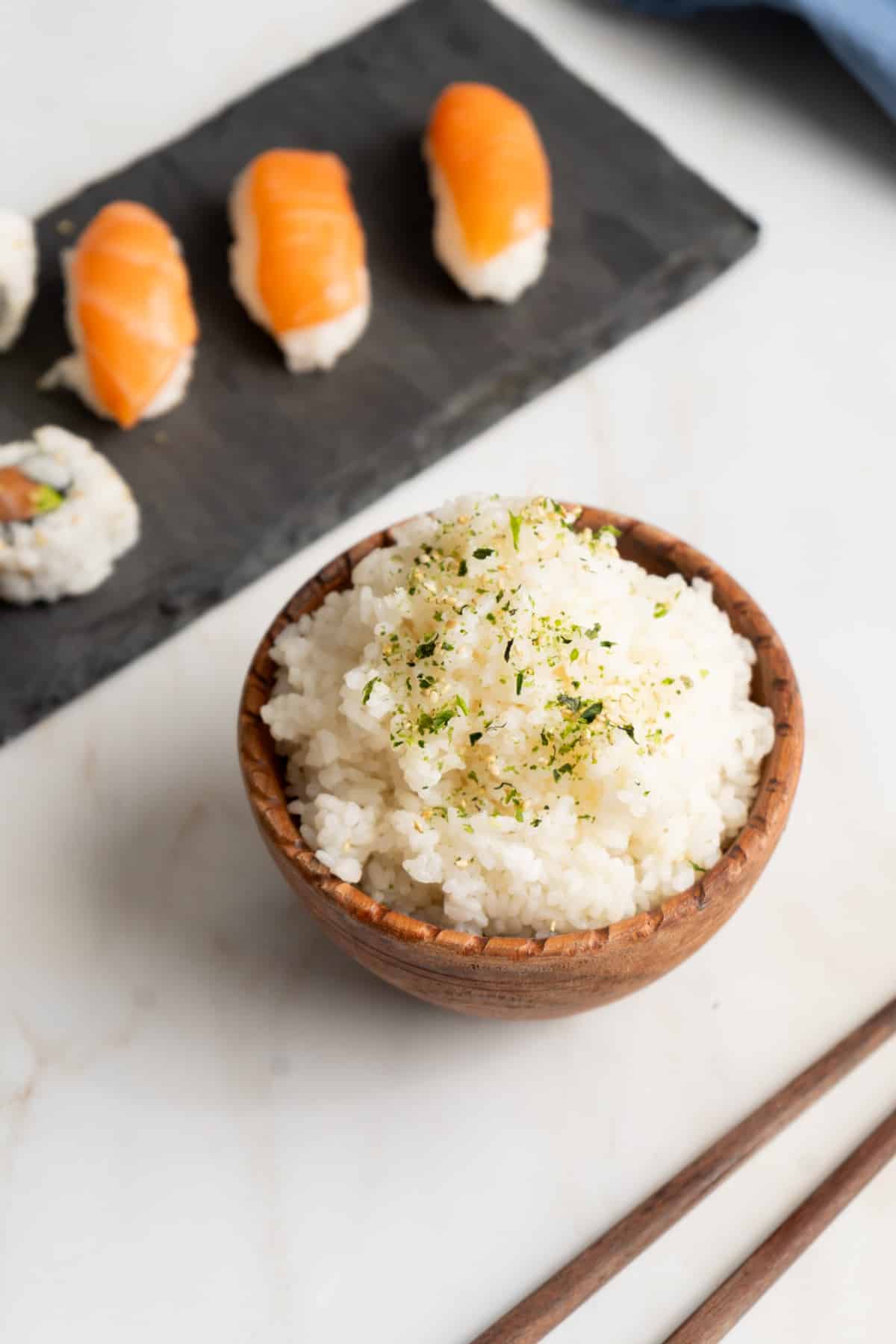
This post may include affiliate links. Please read my disclosure policy.
Our sushi rice recipe is an easy tutorial for perfect authentic sushi rice at home without any fancy equipment.
Sushi rice is made with a specific type of rice, rinsed well, and then cooked like traditional rice. When the rice is still slightly warm you fold or cut in a sugar-vinegar mixture to make it sushi rice.
Sushi rice, aka sticky rice, is good for more than just your favorite sushi roll. You can use it for a homemade poke bowl or sushi bake.
Jump to:
- 📖Why Make This Sushi Rice Recipe
- 🧾Sushi Rice Ingredients
- What type of rice is sushi rice?
- Why add sushi vinegar to rice?
- What is kombu?
- How much sushi rice per roll?
- How much sushi rice for a poke bowl?
- ⏲️How to Make Sushi Rice
- 🥗Ways to Use Sushi Rice
- 👩🏻🍳Expert Tips for the Perfect Sushi Rice
- 🌡️How to Store Sushi Rice
- Frequently Asked Questions
- 📖 Recipe Card
- ⭐Reviews
📖Why Make This Sushi Rice Recipe
Accessible Technique- Making good sushi rice doesn't require a rice cooker or other fancy equipment. I don't use a rice paddle, fan, or wooden tub like the sushi chefs do. But my recipe still gets consistent results for home cooks.
Traditional Flavor- While my cooking process may be different I still use the authentic mixture of rice vinegar, sugar, and salt for a true sour rice flavor.
Sushi rice has just a few ingredients but a very specific flavor and texture.
🧾Sushi Rice Ingredients
Sushi rice has just a few ingredients but a very specific flavor and texture.
Short Grain White Rice- There are over 40,000 varieties of rice. Sushi, like a risotto, is a dish that requires a rice variety with specific characteristics therefore I recommend only using rice that is specifically labeled sushi rice.
Water- I prefer to use water from the filter to keep the taste clean and pure. But for rinsing I just use tap water.
Kombu- Optional, but I recommend trying a batch with and without to see if you like the extra savory flavor.
I like using it when making sushi or poke with raw fish but when using sushi rice with vegetables I prefer to make it without the kombu.
Sushi Vinegar Recipe (sushi-su)
Rice Vinegar- Be sure not to accidentally grab the seasoned vinegar as it will alter the flavor.
Rice vinegar is inexpensive and can be used just like regular vinegar in other dishes, so worth the small investment. In a pinch, champagne vinegar is the closest match.
Sugar & Salt- Pretty simple. I use white cane sugar and kosher salt.
What type of rice is sushi rice?
Sushi rice is a general term for any short-grain or medium-grain polished white rice that is only slightly sticky. Typically, from Japan.
Sometimes called Pearl rice, Glutinous rice, or Japanese rice. Short-grained rice contains a high percentage of starch when compared to other varieties, and this is why the grains are perfectly sticky.
While long-grain rice and medium-grain rice might seem like fine substitutes I don't recommend this for sushi rolls. But you can use the sushi vinegar.
One of my top tips for cooking sushi rice is to find a brand of Japanese short-grain rice that you like and is carried at a store near you.
Each time you cook it you will get better results because you will know the rice so well.
Why add sushi vinegar to rice?
The rice vinegar adds a very slightly sour flavor that is part of authentic Japanese cooking, the sugar adds sweetness to balance out the sour.
The word "sushi" is derived from a Japanese word meaning "sour rice", but most of us think raw fish when we hear sushi.
What is kombu?
A member of the kelp family, kombu is a dried seaweed that is used as an ingredient to provide dishes with umami flavor, nutrients, and minerals. Dried kombu is used in broths, beans, and, of course, sushi rice!
It is available at most large supermarkets in the US. You can also order kombu online.
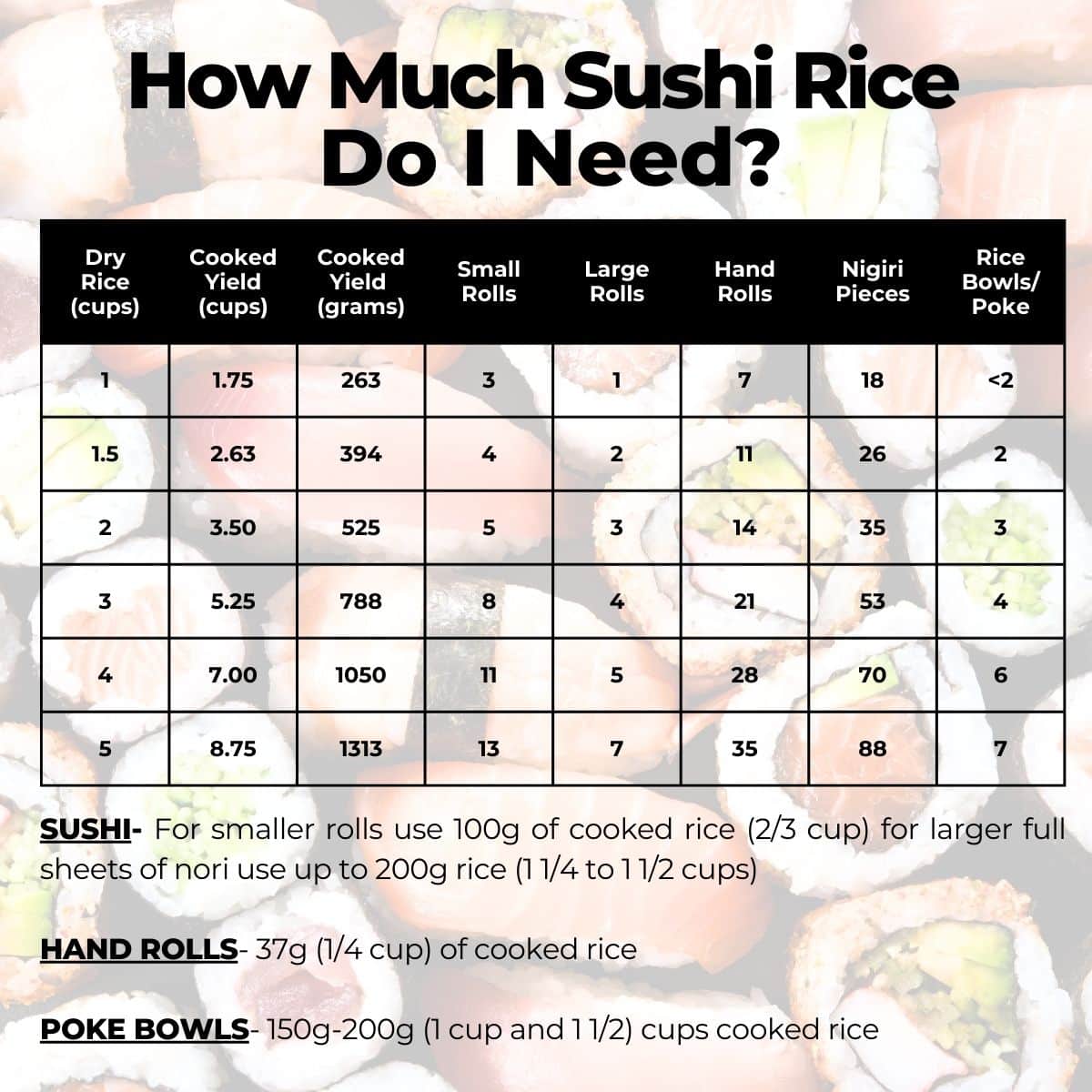
How much sushi rice per roll?
How much sushi rice depends on the type of roll and the size of your nori. Small rolls, think basic tuna roll, will have on average ⅔ cup of rice.
While larger rolls, like a dragon roll, will have between 1 cup and 1 ¼ cups of rice.
How much sushi rice for a poke bowl?
For poke bowls, you typically use between 1 and 1 ½ cups of rice.
⏲️How to Make Sushi Rice
The first time you make sushi rice it may seem intimidating but follow these instructions.
Step 1- Thoroughly Rinse the Rice
This is the most important step to getting the proper texture. Not too sticky or gooey. So, don't skip it!
Start by adding your rice to a large bowl. Fill the bowl with enough water to cover the rice by one inch.
Use your hand to swirl the rice in the water for 30 seconds. Pour the rice into a mesh sieve to strain out the water.
Transfer the rice back to the bowl and repeat the process.
You need to rinse the rice until the water runs clear, it could take 3 washes. It might take 6. It will vary greatly from bag to bag.
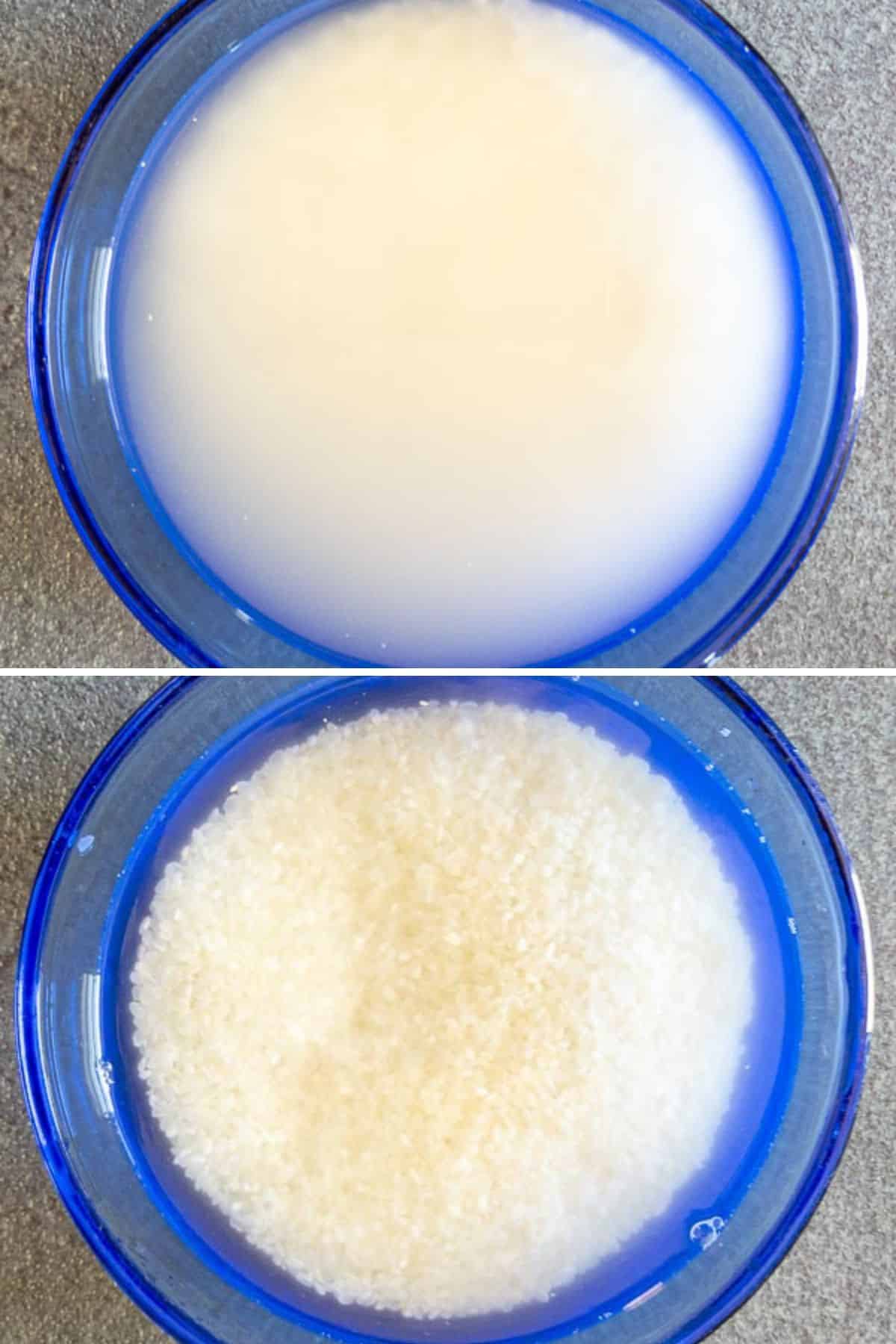
Step 2- Cook the Rice
If you are using kombu give it a dusting off with a damp cloth.
Either on the white rice setting on your rice cooker or on the stovetop. The key is to follow the water-to-rice ratio listed in the recipe and NOT the water-to-rice ratio listed on the bag.
After the initial cooking time, allow the rice to rest. Do not open the lid.
Step 3- Add the Sushi Vinegar
While the rice is resting make the sushi vinegar. I heat mine in the microwave but you can use a small saucepan. You want the sushi vinegar to be warm not boiling hot.
Transfer the rice to a wide shallow bowl. Pour the vinegar mixture over the rice. Use short slicing motions to incorporate the mixture into the rice
Some recipes say you have to use a wooden bowl and paddle. I find a wide shallow ceramic bowl with a wooden spoon is fine.
The goal is to coat each grain. This is what gives the rice its glossy appearance.
Step 4- Cool the Rice
Before making your own sushi rolls you need to let the rice cool. Let it sit on the counter or fan it to speed up the process.
🥗Ways to Use Sushi Rice
In addition to the rice bowls and California rolls we already talked about, this delicious sushi rice can be used as the base for many other dishes.
I use it as a base for my Chinese salt and pepper shrimp and this beef and broccoli stir-fry recipe! But I love it with huli huli chicken and grilled Vietnamese pork.
And leftover sticky rice is great with my quick and easy peanut chicken dinner or eat it for breakfast with a poached egg and a little furikake.
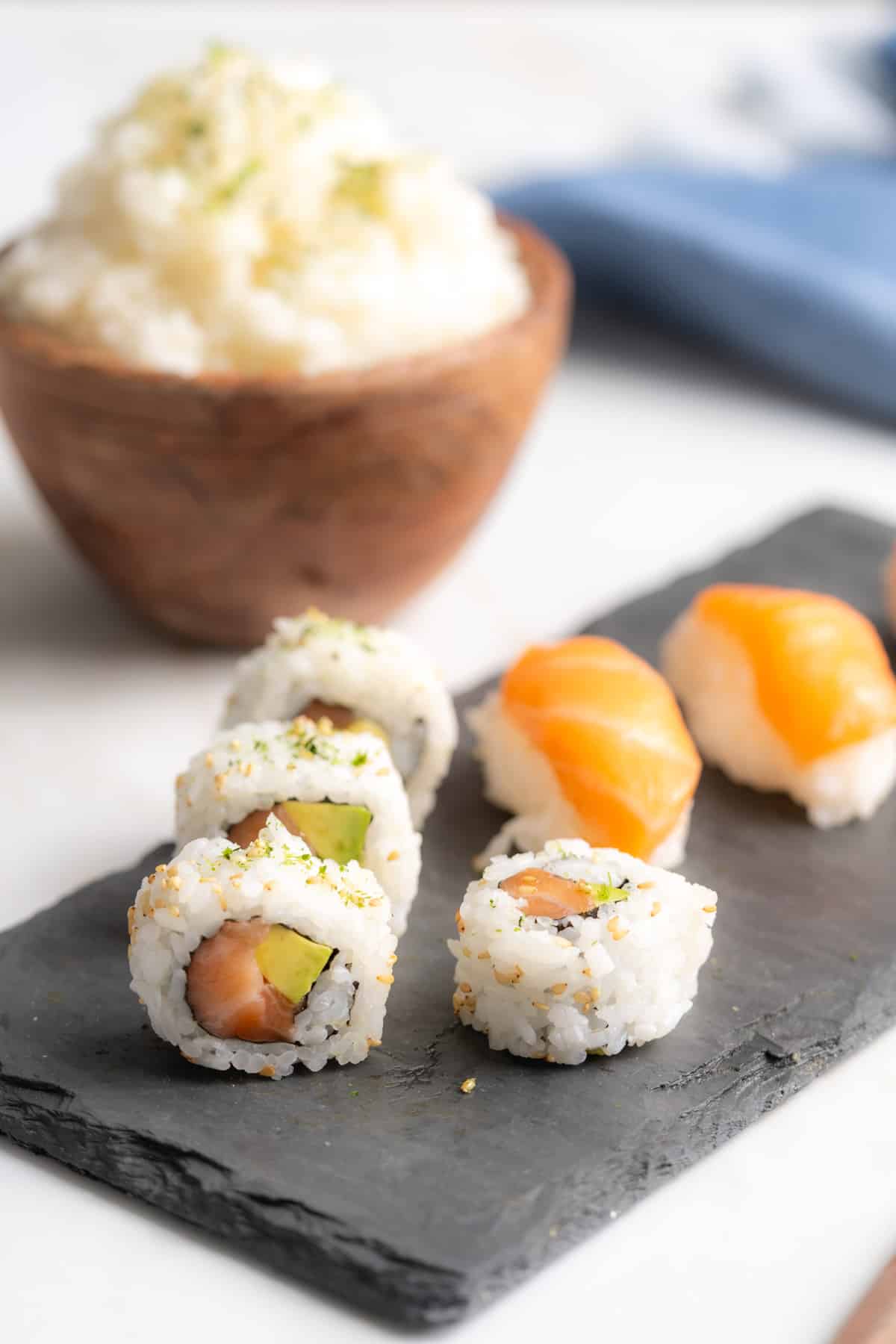
👩🏻🍳Expert Tips for the Perfect Sushi Rice
Perfect sushi rice is slightly sticky, and a little toothsome, and each rice grain is visible.
- Avoid using the rice before it has cooled. This will cause it to become mushy.
- Most rice brands will tell you to add more water than this recipe calls for. Too much water will also cause the rice to become mushy.
- Don't rush the resting process, too short and the rice is undercooked, too long, and it is overcooked.
- The perfect size pot will have 1 ½ to 2 inches of headroom after you add the water to allow for steam to form. Otherwise, you will have pockets of uncooked rice.
- Be careful when washing the grains. Too furious of washing can cause the grains to break apart. This will create globs in your rice. A nice gentle swirling motion is perfect.
- Again, be gentle when adding the vinegar mixture. Aggressive stirring will cause lumpy rice.
🌡️How to Store Sushi Rice
Store in an airtight container in the refrigerator for 2 to 3 days. Also, allow your rice to cool before placing it in the fridge, and allow it to return to room temperature before using it.
It is also common to keep sushi rice on your counter covered with a wet towel overnight, or for up to 12 hours.
Can you freeze sushi rice?
You can freeze sushi rice just like regular cooked rice. After it cools to room temperature (don't leave it out too long), divide it into freezer bags and freeze.
To thaw the frozen sushi rice, transfer the desired amount from the freezer to the refrigerator and let it defrost gradually. You can also use a microwave on a low-power setting or gently reheat it in a steamer.
How to Reheat Sushi Rice
You can eat sushi rice at room temperature. Simply leave it out for 30 to 45 minutes to warm. You can also reheat it in the microwave, just be sure to add water and cover it.
Frequently Asked Questions
Brown rice won't be as sticky as sushi rice but here are a few tips. First, rinse your short-grain brown rice before soaking it for one hour.
Boil the rice until it is done, don't steam it. Drain off the excess water and add the sushi vinegar.
There are 3 reasons sushi rice gets mushy. First, being too aggressive with the rice during rinsing or string will cause the grains to break and release excess starch. Second, the rice was overcooked. And third, excess water.
oom temperature or slightly warmer, about body temperature, is perfect for rolling sushi. Do not use hot rice or cold rice.
Traditional sushi rice, like this recipe, is naturally gluten-free. However when ordering sushi out always double-check as many restaurants customize their sushi rice seasoning and soy sauce might be included.
Did You Enjoy Making This Recipe? Please rate this recipe with ⭐⭐⭐⭐⭐ or leave a comment. It helps other wonderful people connect with my food.
📖 Recipe Card
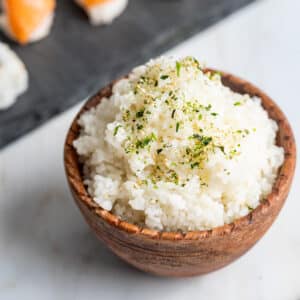
Sushi Rice
Ingredients
- 2 cups Japanese or sushi rice
- 2 cups filtered water
- 1 2" square kombu, optional also called dried kelp
- 3 Tablespoons rice vinegar
- 2 Tablespoons granulated sugar
- 1 teaspoon kosher salt
Instructions
- Place the rice into a large mixing bowl and cover with cool water. Swirl the rice in the water with your hand, quickly drain the rice and repeat until the water is clear. This will take 3 to 6 rinses. Drain the rice in a colander.
- Combine the rice, kombu, and 2 cups of water into a medium saucepan* and place over high heat. Bring to a boil, uncovered. Reduce the heat to low and cover. Cook for 15 minutes.2 cups Japanese or sushi rice, 2 cups filtered water, 1 2" square kombu, optional
- Remove from the heat and let stand, covered, for 10 minutes. Discard the kombu.
- To make the sushi vinegar mixture combine the rice vinegar, sugar, and salt in a small bowl and heat in the microwave on high for 30 seconds.3 Tablespoons rice vinegar, 2 Tablespoons granulated sugar, 1 teaspoon kosher salt
- Transfer the rice into a large mixing bowl, Use a nonmetallic bowl to prevent any interaction with the rice vinegar. Add the vinegar mixture. Fold the mixture through the rice using a slicing motion, being careful not to crush the rice. Try to coat each grain of rice with the vinegar mixture. Cool to room temperature by fanning the rice as you fold.
Video
Notes
- Sushi rice can also be made in a rice cooker using the 'white rice' setting.
- Kombu is a great addition if you can find it. Most major grocery store chains carry it but is often sold out.







Aline says
So happy to have come across this recipe! Now we don't have to order sushi!! This will be a fun date night this week! Thank you!
Sam | Ahead of Thyme says
Your sushi rice looks so sticky! I was just thinking of making some sushi at home this week, so this will be perfect. Can't wait to try it!
LaKita says
Your sushi rice looks so sticky and perfect! The rice is definitely the most important part to any good sushi recipe!
LINDSEY PINE says
I can't believe there are so many thousands of types of rice! Wow! The rice is definitely a super important part of perfect sushi
Paula Montenegro says
I like this post, simple and to the point! And I hadn't heard of kombu, so there's an extra flavor to try!
tatiana says
Exactly what I was looking for! This is easy to follow and gave me delicious rice for my sushi!
Jen says
So happy to hear!
Amanda says
I'm so glad I came across this recipe! I've always wanted to make sushi at home. I bet it'd also be great in a poke bowl.
Candice says
Thank you so much for this awesome sushi rice recipe! We've been craving sushi lately, and decided to make it ourselves. It was fantastic and exactly what we needed. Thank you for the great recipe!
veenaazmanov says
Thanks very interesting and detailed explanation. Makes life so easy.
Jen says
Absolutely!
Jacqui DeBono says
The slightly sticky texture is the best! I like all my rice that way. I usually just prepare with water, really excited to try it with the sushi vinegar mixture!